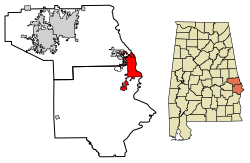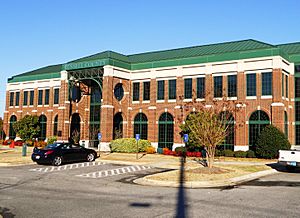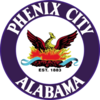Phenix City, Alabama facts for kids
Quick facts for kids
Phenix City, Alabama
|
|||
|---|---|---|---|

Aerial view of Phenix City (c. 2009)
|
|||
|
|||

Location of Phenix City in Lee and Russell counties, Alabama.
|
|||
| Country | United States | ||
| State | Alabama | ||
| Counties | Russell, Lee | ||
| Area | |||
| • Total | 28.25 sq mi (73.17 km2) | ||
| • Land | 28.14 sq mi (72.87 km2) | ||
| • Water | 0.11 sq mi (0.29 km2) | ||
| Elevation | 243 ft (74 m) | ||
| Population
(2020)
|
|||
| • Total | 38,817 | ||
| • Density | 1,379.58/sq mi (532.65/km2) | ||
| Time zones | UTC-5 (EST (de jure)) | ||
| • Summer (DST) | UTC-5 (CDT (de jure)) | ||
| UTC-5 (EST (de facto)) | |||
| • Summer (DST) | UTC-4 (EDT (de facto)) | ||
| ZIP codes |
36867-36870
|
||
| Area code(s) | 334 | ||
| FIPS code | 01-59472 | ||
| GNIS feature ID | 0155193 | ||
Phenix City is a city located in Lee and Russell counties in the U.S. state of Alabama. It is the main city for Russell County. In 2020, about 38,817 people lived there.
Phenix City is right across the Chattahoochee River from Columbus, Georgia. Even though most of Alabama uses Central Time, Phenix City uses Eastern Time. This is because it has strong business connections with Columbus, Georgia.
In 2007, BusinessWeek magazine said Phenix City was the best affordable suburb in the country for raising a family. The city is home to Chattahoochee Valley Community College, where everyone who applies gets accepted. Troy University also has a campus in Phenix City.
As of 2023, the mayor of Phenix City is Eddie N. Lowe. He is the first Black mayor elected by the public in the city's history.
Contents
Exploring Phenix City's Location
Phenix City is located at 32°28′22″N 85°1′12″W / 32.47278°N 85.02000°W. It is the city furthest east in Alabama. It is also the easternmost place in the Central Time Zone. However, as mentioned, it uses the Eastern Time Zone because it is so close to Georgia.
The city covers about 24.8 square miles (64.2 square kilometers). Most of this area is land, with only a small part being water.
Phenix City's Weather
The weather in Phenix City usually has warm temperatures and rain spread out throughout the year. It has a humid subtropical climate. This means it has hot, humid summers and mild winters.
| Climate data for Phenix City, Alabama | |||||||||||||
|---|---|---|---|---|---|---|---|---|---|---|---|---|---|
| Month | Jan | Feb | Mar | Apr | May | Jun | Jul | Aug | Sep | Oct | Nov | Dec | Year |
| Mean daily maximum °F (°C) | 57 (14) |
61 (16) |
69 (21) |
77 (25) |
84 (29) |
90 (32) |
92 (33) |
91 (33) |
86 (30) |
77 (25) |
68 (20) |
59 (15) |
76 (24) |
| Mean daily minimum °F (°C) | 36 (2) |
39 (4) |
45 (7) |
52 (11) |
61 (16) |
69 (21) |
72 (22) |
71 (22) |
66 (19) |
54 (12) |
44 (7) |
38 (3) |
54 (12) |
| Average precipitation inches (mm) | 4.1 (100) |
4.5 (110) |
5.7 (140) |
4.1 (100) |
3.8 (97) |
3.9 (99) |
5.3 (130) |
4 (100) |
3.3 (84) |
2.3 (58) |
3.6 (91) |
4.5 (110) |
49.1 (1,250) |
| Source: Weatherbase | |||||||||||||
A Look at Phenix City's Past

Some people believe that the last battle of the Civil War happened in Phenix City. Back then, this area was known as Girard.
Phenix City started as two separate towns next to each other. To the south was Girard, and to the north was Brownville. Brownville was in Lee County. Because another town already had the name Brownville, the post office called it "Lively." The train station nearby was called Knight's Station. Even with the confusion, people liked the name Brownville. It officially became a town on February 23, 1883.
Within ten years, the name was changed to Phenix (or Phenix City). It's not clear if it was named after Phenix Mills in nearby Columbus, Georgia, or the mythical bird that rises from ashes. It appeared as Phenix City in the 1890 U.S. Census and was officially made a city on February 19, 1897.
On August 9, 1923, Girard and Phenix City officially joined together. They decided to keep the name Phenix City. Since the city was still split between two counties, the part in Lee County was moved entirely into Russell County in 1932.
In 1926, the Russell County part of Phenix City became the second county seat. A county seat is the main town where the county government is located. By 1934-1935, Phenix City became the only county seat for Russell County.
In 1955, Phenix City won the All-America City Award. This award recognizes cities that work together to solve problems in their communities.
Even though the city was fully in Russell County in 1932, it has grown back into Lee County. In 2010, about 4,200 people lived in the Lee County part of Phenix City.
Places of Worship in Phenix City
Phenix City has many Christian churches. These include:
- Protestantism
- Baptist churches, including those from the Southern Baptist Convention
- United Methodist Church and other Methodist churches
- Seventh-day Adventist churches
- Roman Catholic churches
- The Church of Jesus Christ of Latter-day Saints
Who Lives in Phenix City?
Here's how the population of Phenix City has grown over the years:
| Historical population | |||
|---|---|---|---|
| Census | Pop. | %± | |
| 1880 | 2,224 | — | |
| 1890 | 3,700 | 66.4% | |
| 1900 | 4,163 | 12.5% | |
| 1910 | 4,555 | 9.4% | |
| 1920 | 5,432 | 19.3% | |
| 1930 | 13,862 | 155.2% | |
| 1940 | 15,351 | 10.7% | |
| 1950 | 23,305 | 51.8% | |
| 1960 | 27,630 | 18.6% | |
| 1970 | 25,281 | −8.5% | |
| 1980 | 26,928 | 6.5% | |
| 1990 | 25,312 | −6.0% | |
| 2000 | 28,265 | 11.7% | |
| 2010 | 32,822 | 16.1% | |
| 2020 | 38,817 | 18.3% | |
| U.S. Decennial Census 2018 Estimate |
|||
Phenix City's Population in 2010
In 2010, there were 32,822 people living in Phenix City. There were about 13,243 households. The city had about 1,334 people per square mile.
The people living in Phenix City were made up of:
- 48.7% White
- 46.6% Black or African American
- 0.3% Native American
- 0.7% Asian
- 0.2% Pacific Islander
- 1.4% from other races
- 2.2% from two or more races
About 4.0% of the people were Hispanic or Latino.
About 31.8% of households had children under 18. The average household had 2.44 people. The average family had 3.03 people.
The median age in the city was 33.1 years old. This means half the people were younger than 33.1, and half were older.
Phenix City's Population in 2020
| Race | Num. | Perc. |
|---|---|---|
| White (non-Hispanic) | 15,525 | 40.0% |
| Black or African American (non-Hispanic) | 18,795 | 48.42% |
| Native American | 100 | 0.26% |
| Asian | 366 | 0.94% |
| Pacific Islander | 61 | 0.16% |
| Other/Mixed | 1,658 | 4.27% |
| Hispanic or Latino | 2,311 | 5.95% |
As of the 2020 United States census, there were 38,816 people living in Phenix City. There were 14,716 households and 9,170 families.
Time Zone Differences
Even though Alabama is officially in the Central Time Zone, Phenix City uses Eastern Time. This is because it is very close to the larger city of Columbus, Georgia. Many people in Phenix City work or do business in Columbus. Areas within 10-15 miles of Phenix City, like Smiths Station, also follow Eastern Time.
Media and Local News
Phenix City has three local radio stations. They are WHTY (1460 AM), WURY-LP (97.1 FM), and WGSY (100.1 FM).
Getting Around Phenix City
The Phenix City Express provides local bus service. It has two routes within the city. These routes also connect with the METRA Transit System in Columbus, Georgia.
Phenix City's Sister Cities
Phenix City has special connections with cities in other countries. These are called "sister cities":
 Colomiers, France
Colomiers, France Kamenice, Czech Republic
Kamenice, Czech Republic Västerås, Sweden
Västerås, Sweden
Famous People from Phenix City
Many notable people have come from Phenix City, including:
- Jo Jo Benson, an R&B singer
- Hugh A. Bentley, who helped improve Phenix City in the 1950s
- Simeon Castille, a former NFL cornerback
- Wally Chambers, a former NFL defensive tackle
- Rodney Cooper, a basketball player
- Harvey Glance, a track-and-field star who competed in the 1976 Summer Olympics
- Aidan Gould, a child actor
- Nolan Gould, a child actor
- Bishop Harris, a former college football coach
- Freddie Hart, a country singer who wrote a song called "Phenix City"
- Tim Hudson, a Major League Baseball pitcher
- Billy Jackson, a former NFL running back
- Van Jakes, a former NFL cornerback
- James Joseph, a former NFL running back
- Kasey Kiker, a Major League Baseball player
- Boise Kimber, a minister and civil rights activist
- Ed King, a former NFL offensive guard
- Herm Lee, a former NFL offensive tackle
- Eddie Lowe, a former Canadian Football League player and the current mayor of Phenix City
- Woodrow Lowe, a former NFL player and College Football Hall of Fame member
- Triandos Luke, a former NFL wide receiver
- Joe Meriweather, a former NBA player
- John Malcolm Patterson, a former Governor of Alabama
- Colby Rasmus, a Major League Baseball outfielder
- David Ray, a former NFL placekicker
- Tommie Robinson, a football coach
- Jimmie Spheeris, a singer-songwriter
- Rob Spivery, a former basketball player and coach
- Rufus Stokes, an inventor
- Ucambre Williams, a football player
- Bruce Stephens, a former NFL wide receiver
Images for kids
-
Phenix City Post Office (ZIP Code: 36867)
-
The Brooks-Hughes House was added to the National Register of Historic Places on November 3, 1983.
-
The Floyd-Newsome House was added to the National Register of Historic Places on November 3, 1983.
-
The Morgan-Curtis House was added to the National Register of Historic Places on November 3, 1983.
-
The Shapre-Monte House was added to the National Register of Historic Places on November 3, 1983.
See also
 In Spanish: Phenix City (Alabama) para niños
In Spanish: Phenix City (Alabama) para niños











